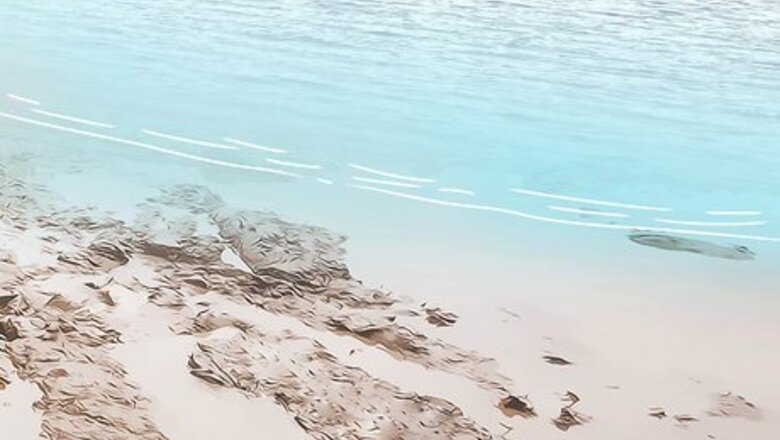
views
Digging for Bloodworms
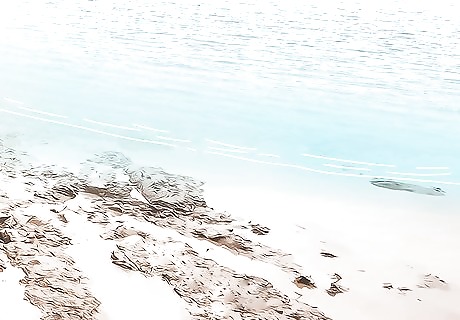
Search for bloodworms along muddy coastlines during low tide. Since bloodworms are native to saltwater, you can only find them along ocean coastlines. Wait until the low tide when the water recedes and leaves thick muddy flats along the coast. You’ll find the worms burrowed in the mud so they don’t dry out. You can go searching for bloodworms at any time during the day. Maine, New Jersey, and Connecticut are known for having a large number of bloodworms along their coasts. Try asking local bait and tackle shops to see if they know of any areas where other people have caught bloodworms.
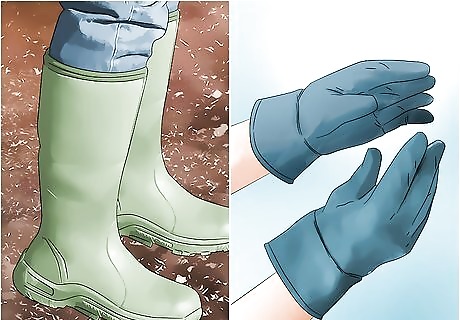
Put on long boots and protective gloves. You’ll have to walk through some deep and thick mud to find your bloodworms, so your regular shoes could get really dirty or even stuck. Put on some boots that go up past your thighs to ensure you stay clean. Bloodworms also have retractable jaws and a painful bite, so wear a pair of thick gloves to stay protected. Your gloves also keep your hands clean and safe from anything sharp that might be buried in the mud. A bloodworm bite feels similar to a bee sting and some people may experience an allergic reaction, but they aren’t normally dangerous.

Check underneath rocks to find any hidden bloodworms. If you notice any rocks sticking out of the mud nearby, carefully try picking them up and setting them aside. You might see a bloodworm that’s partially exposed on the surface so it’s easier to catch. If you don’t see any worms, just put the rock back where it was.
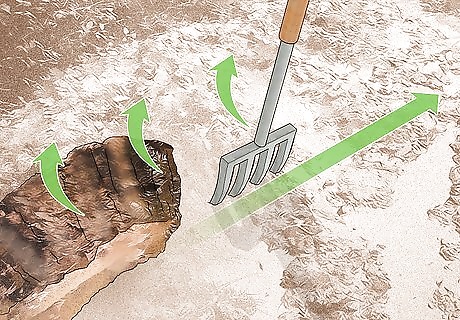
Scoop mud out in a fanned-out pattern using a garden fork. Look around for tiny holes in the surface of the sand since that might be a sign bloodworms are buried there. Push the tines of the fork about 6–12 inches (15–30 cm) into the mud to find the most bloodworms. Pour the mud off the side of the fork to spread it out so it’s easier to sift through. Fan out and keep digging so you can search through a larger area. Since it’s easy to sink and get stuck in the mud, try to keep moving. Reposition your feet when you feel like you’re sinking in the mud. You can also use a worm digging tool, which looks like a handheld garden fork with the tines angled backward. That way, it’s easier to scoop and dig the mud.
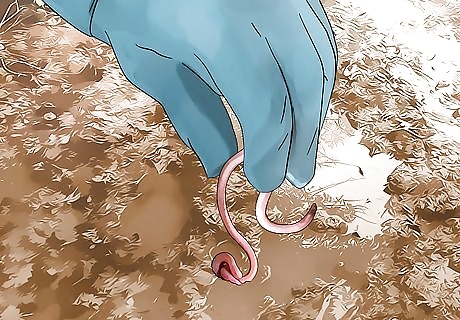
Pick up the bloodworm gently by hand when you find one. Bloodworms are dark pink or red, but they might be covered in mud when you find them. When you see one in the loose mud, gently pinch the center of the worm’s body between your fingers and pick it up. Avoid grabbing near the head, which is usually the thicker end, since the worm could bite.
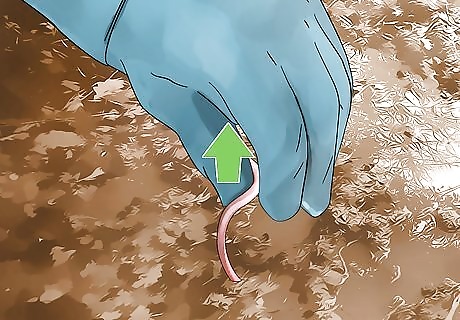
Pull the worm out slowly if it’s partially buried. Avoid grabbing and yanking the worm out from the ground since you could break its body apart. Keep a gentle grip on the worm and carefully guide it straight out from the ground.

Store the worms in a bucket or other plastic container. Grab a large bucket or plastic container and add a few inches of saltwater and mud to the bottom. Toss your bloodworm in the bucket and continue the search. You can pile all of the bloodworms you catch on top of each other as you collect them.
Storing Your Worms
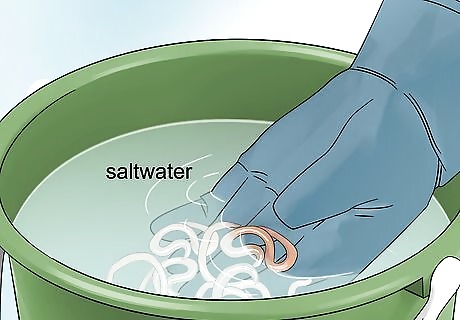
Clean your worms off with saltwater. Collect some clean water while you’re out near the coast in another container or bucket. Take your bloodworms out of the bucket and transfer them to the saltwater. Rinse off all of the leftover mud so your worms look clean. Bloodworms could die when they’re exposed to freshwater, so don’t use it when you clean them off.
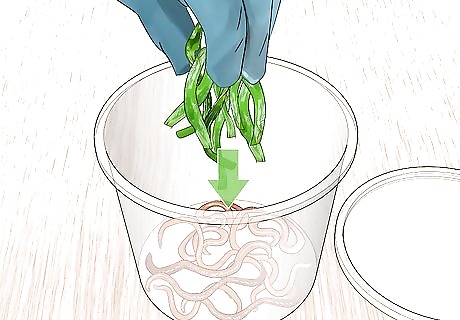
Put your worms in a container with seaweed that’s soaked in saltwater. You can use any small plastic container or a resealable plastic bag to store your worms. It’s okay to fill about a third of your container with worms, but you may want to use multiple containers if you have more than a dozen. Take some fresh, damp seaweed and place it on top of the bloodworms so they stay moist until you’re ready to use them. Seaweed helps keep the bloodworms moist so they don’t dry out and die. You can collect seaweed from the wild, or you might be able to find it at local bait or aquarium shops. You can also use newspapers or newsprint if you don’t have access to seaweed.

Store the worms in your fridge. Bloodworms prefer cool environments, so your fridge is the perfect place to keep them alive. Place the worms away from where the cold air enters your fridge since it could hurt or kill the worms before you’re able to fish with them. Keeping bloodworms in your fridge slows down their metabolism so they stay alive longer.

Use your bloodworms within 3–4 days. Bloodworms can’t survive for very long outside of the water even if you keep them in the proper environment. Use your bloodworms as bait during the week you catch them so you can get the best results when you’re fishing. The cold temperatures will make your worms move slower and they may seem like they’re dead, but they will still move and react when you handle them. If your bloodworms die, throw them away with your regular trash.
Fishing with Bloodworms
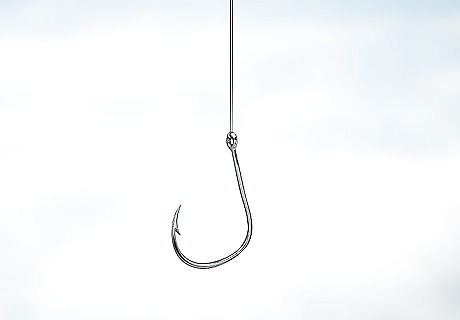
Fish with a circle hook so it’s easier to rig your worm. Circle hooks are slightly wider and rounder than traditional hooks so you have more room to attach your worm. If you can, look for a hook that angles slightly to the side of the shaft to make it even easier. Rig the hook to your line and tie it tightly. You can use bloodworms for any type of saltwater fish.

Push the hook through the worm’s head. Wear gloves when you handle the worm so you don’t get bitten. Pinch the base of the worm’s thicker end with your dominant hand and hold the hook in your non-dominant hand. Carefully push the point of the hook straight into the worms head so it’s not able to move around. You might see a little blood coming out of the worm as soon as you insert the hook, but that’s normal. You can also break a bloodworm in half so you don’t go through as much bait.
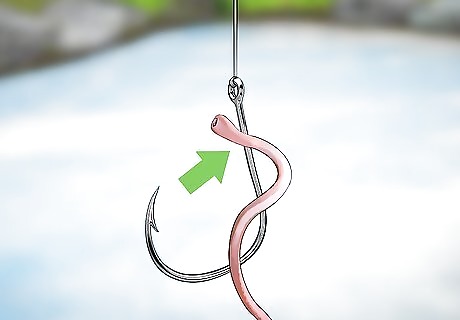
Slide the top of the bloodworm toward the top of the hook. Guide the worm’s head up the shaft so the hook goes through its body. Once you have about half or three-quarters of the body on the hook, let the tail dangle off the end. This will help keep the worm securely on your line and make it less likely that a fish will eat it without striking your hook.
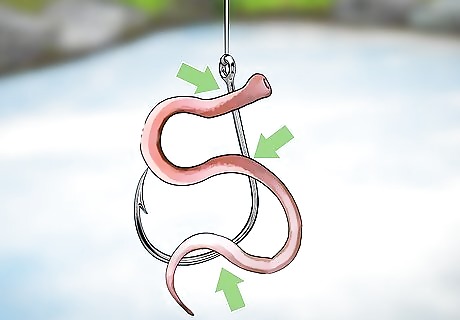
Poke the hook through 1–2 more places along the worm’s body. Pinch the back of the worm gently and push the hook through the middle of its body. Leave a little bit of the worm’s tail free so it hangs off the hook to attract more fish. Once you have your worm on the hook, you’re ready to cast and start fishing! Try to hide as much of the hook as you can using the worm so you’re less likely to scare fish away.
















Comments
0 comment